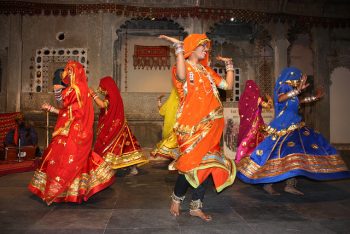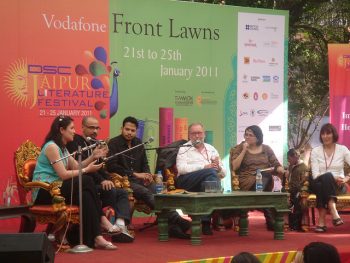Levels of Language: Register in Hindi, Part 1 Posted by Rachael on Dec 17, 2017 in Hindi Language, Uncategorized
“Register” simply refers to the various levels of speech that exist in any language––such as formal, informal/colloquial, slang, etc. Just as we have different registers in English, like the formal language you would use in a research paper or the slang terms you use when talking to a close friend, there are different registers in Hindi. Because Hindi, like English, is a mixture of many different languages, oftentimes its different registers correspond to different languages, as we’ll see below.
The linguistic definition of “register,” according to the Oxford English Dictionary, is “a variety or level of usage, especially as determined by social context and characterized by the range of vocabulary, pronunciation, syntax, etc., used by a speaker or writer in particular circumstances.” This definition sums up wonderfully the inextricable connection between social context and language, which is a particularly important consideration in India. Here, the divisions between disparate social spaces are much more pronounced in terms of linguistic register than in the United States. It is common for Indian families, especially those who live in villages and/or small towns, to speak one language at home with one’s family and another, completely different one at the office and in other formal settings and another, completely different language or variety of language with one’s friends. For example, one of my close friends, who is from a small textile town called Bhilwara, in the state of Rajasthan, would speak Rajasthani or Marwari (a variety of Rajasthani, which actually refers to a group of related languages) with his family and with his maids and others who worked in his house, Hinglish or a combination of English and Hindi with his friends and more formal, Sanskritized Hindi or, more often, English at the office.
The situation is even more complex for those who have moved away from their native states. For example, the host family with whom I lived when I first visited Jaipur were originally from West Bengal, so they spoke colloquial Bengali with each other (called “cholit bhasha,” which is quite different from “shaadhu bhasha” or the formal, heavily Sanskritized version of the language), Rajasthani with maids and other locals with whom they had a close relationship and Hindi or English with me and others who were not close to them socially and/or could not speak either Bengali, Rajasthani or Marwari.
Of course, the situation does not always involve completely different languages, but sometimes different dialects or registers of a language. For example, “Hinglish” is not an entirely different language to Hindi, rather it is a pidgin or non-standard combination of English and Hindi words, phrases and idioms used to facilitate conversation amongst those who have been at least partially educated in English and is used generally amongst the younger, wealthier and more mobile demographic of Indians. This is a colloquial way of speaking with peers, whereas the use of heavily Sanskritized Hindi is commonplace in Hindi literary festivals, for instance, where “Modern Standard Hindi” (often abbreviated MSH) is being celebrated for, specifically, its ties to Sanskrit, a classical language. Perhaps a register that lies between these two ( heavily Sanskritized Hindi and Hinglish) would be what is sometimes known as “Hindustani,” which includes a liberal mixture of more common Sanskrit words, other desi words of most likely Prakrit heritage and Persianate and Arabic-related words.
Let’s look more in depth at the most formal register of Hindi, the highly Sanskritized variety, below:
Heavily Sanskritized Hindi is not common in daily life (well, except in Hindi-language newspapers). You will often see such extremely formal language on Hindu wedding invitations, where it is not unusual to see the following words and phrases:
शुभ विवाह समारोह/shubh vivaah samaaroh: auspicious wedding celebration. A more colloquial way of saying this would be “शादी का त्योहार/shaadi ka tyohaar,” and a more colloquial way of saying “auspicious” would be something like “मुबारक/mubaarak,” which you may have heard in expressions of celebration and congratulation, as in, जन्मदिन मुबारक हो/janmadin mubaarak ho or “Happy Birthday!”
सुपुत्र, सुपुत्री/suputra, suputri: (good) son, (good) daughter. The addition of “सु/su” (a Sanskrit prefix) also attributes positive qualities to a thing or person, whereas the Sanskrit prefixes “दुर्/dur” (often changed to दु:/duh when combined with a “स/s” or a “श/sh” as in दु:शील/duhsheel or having a bad character and दु:स्वप्न or bad dream/nightmare) and “कु/ku” (as in कुरूप/kuroop or ugly, ill-formed and कुपुत्र/kuputra or “bad son”) always attribute negative qualities to a person or thing. A more common way of saying “son” and “daughter” here would be “बेटा/betaa” and “बेटी/beti.”
श्री, श्रीमती/shree, shreemati: Mister (Mr.), Missus (Mrs.). More common ways of saying this would simply be the English “sir” (often pronounced सर/sar) or “mister” (मिस्टर) and “madame” (मेडम). Another, common way of addressing a man you don’t know who is not your social superior is “भाई साहब/bhaai sahab” or “brother sir.”
एवं/evam: and (but only used in special cases to link words and phrases; this is not an equivalent of “और/aur”).
संग/sang: with. More common is “के साथ/ke saath.”
स +/ s +: A Sanskrit prefix meaning “with,” such as in “सपरिवार/saparivaar” (with one’s family). Another Sanskrit equivalent of this is परिवार के समेत/parivaar ke samet, again, “with one’s family”
And here’s a sample wedding message for you to decode:
X एवं Y का शुभविवाह बुधवार, ८ फ़रवरी २०१२ को होना सुनिश्चित (fixed, decided auspiciously) हुआ है । हमारी हार्दिक (wholehearted) अभिलाषा (desire) है कि परिणय (marriage or, literally, the groom leading the bride around the sacred fire) की इस मंगल (auspicious) बेला (occasion) में आपका सानिध्य (attendance) एवं शुभाशीष (auspicious blessing) से इनका मंगलमय (auspicious) जीवन पथ आलोकित (illuminated) हो ।
(X (दूल्हा/doolhaa=groom) evam Y (दुल्हन/dulhan=bride) kaa shubh vivaah budhvaar, 8 farvari 2012 ko honaa sunishchit huaa hai. humaari haardik abhilaashaa hai ki parinay ki is mangal belaa me aapkaa saanidhya evam shubhaasheesh se inkaa mangalmay jeevan path aalokit ho)
If you are unsure as to whether a word comes from Sanskrit or not, here are a few hints. Only words from Sanskrit include the following letters and conjuncts (a combination of two letters), which are a direct borrowing from the Sanskrit syllabary:
ऋ=in Hindi, this is pronounced as “ri” as in ऋषि/rishi (sage).
क्ष=a combination of the letters “क” and “ष” that is pronounced “ksha” as in “कक्षा/kakshaa” (classroom or class).
ष=in Hindi, pronounced the same as “श/sha,” as in भाषा/bhaashaa (language).
ण=in Hindi, this is often not pronounced “correctly,” (that is, according to its Sanskrit pronounciation) and is rendered as a regular “न/na” sound. An example is ऋण/rin or “debt.”
ह्र=a combination of the letters “ह” and “र” as in the Sanskrit loanword ह्रदय/hriday or “heart.”
Of course, there are other conjuncts that are found only in Sanskrit words but, for now, this list will do. It is best to acquire this knowledge gradually as one learns the language, rather than trying to memorize long lists of letters and conjuncts.

Build vocabulary, practice pronunciation, and more with Transparent Language Online. Available anytime, anywhere, on any device.






